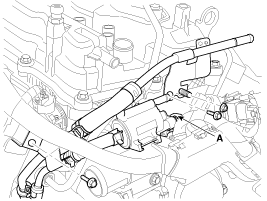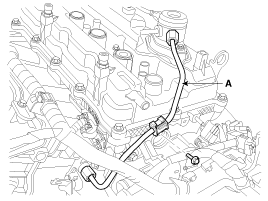 Hyundai Santa Fe: Cylinder Head Cover. Repair procedures
Hyundai Santa Fe: Cylinder Head Cover. Repair procedures
Removal
| 1. |
Disconnect the battery negative terminal.
|
| 2. |
Remove the engine cover.
|
| 3. |
Remove the air duct and air cleaner assembly.
|
| 4. |
Disconnect the exhaust OCV (Oil control valve) connector
(A).
|
| 5. |
Disconnect the ignition coil connectors (A) and the
fuel pump connector (B), then remove the wiring protector (C).
|
| 6. |
Remove the ignition coils.
|
| 7. |
Disconnect the fuel hose (A) and PCSV (Purge control
solenoid valve) hose (B).
|
| 8. |
Disconnect PCSV (Purge control solenoid valve) connector
(A) and loosen the vacuum & PCSV (Purge control solenoid valve) pipe
assembly mounting bolts and nut.
|
| 9. |
Remove the high pressure pipe (A).
|
| 10. |
Remove the high pressure fuel pump (A) and the roller
tappet (B).
|
| 11. |
Disconnect the PCV (Positive crankcase ventilation)
hose (A).
|
| 12. |
Remove the front engine hanger (A).
|
| 13. |
Remove the cylinder head cover (A).
|
Installation
| 1. |
Install cylinder head cover.
|
| 2. |
Install the front engine hanger (A).
|
| 3. |
Connect the PCV (Positive crankcase ventilation)
hose (A).
|
| 4. |
Install the high pressure fuel pump.
|
| 5. |
Install the high pressure pipe (A).
|
| 6. |
Connect PCSV (Purge control solenoid valve) connector
(A) and tighten the vacuum & PCSV (Purge control solenoid valve) pipe
assembly mounting bolts and nut.
|
| 7. |
Connect the fuel hose (A) and PCSV (Purge control
solenoid valve) hose (B).
|
| 8. |
Install the ignition coils.
|
| 9. |
Connect the ignition coil connectors (A) and fuel
pump connector (B) after installing the wiring protector (C).
|
| 10. |
Connect the exhaust OCV (Oil control valve) connector
(A).
|
| 11. |
Install the air cleaner assembly.
|
| 12. |
Install the engine cover.
|
 Cylinder Head Cover. Components and Components Location
Cylinder Head Cover. Components and Components Location
Components 1. Cylinder head cover 2. Gasket ...
 CVVT & Camshaft. Components and Components Location
CVVT & Camshaft. Components and Components Location
Components 1. Camshaft bearing cap 2. Camshaft front bearing cap 3. Exhaust camshaft 4. Intake camshaft 5. Exhaust CVVT assembly 6. Intake CVVT assembly 7. Exhaust camshaft upper bearing 8. Intake camshaft ...
See also:
Rear seat folding from outside
Pull the rear seat back folding lever out. The rear seat back will be folded. If you pull the left side lever (1) out, left side seat back and center seat back will be folded. If you pull the right side ...
Closing the tailgate
To close the tailgate, lower and push down the tailgate firmly. Make sure that the tailgate is securely latched. WARNING - Exhaust fumes If you drive with the tailgate open, you will draw dangerous exhaust ...
If engine turns over normally but does not start
1. Check fuel level. 2. With the ignition switch in the LOCK position, check all connectors at ignition coils and spark plugs. Reconnect any that may be disconnected or loose. 3. If the engine still does ...












